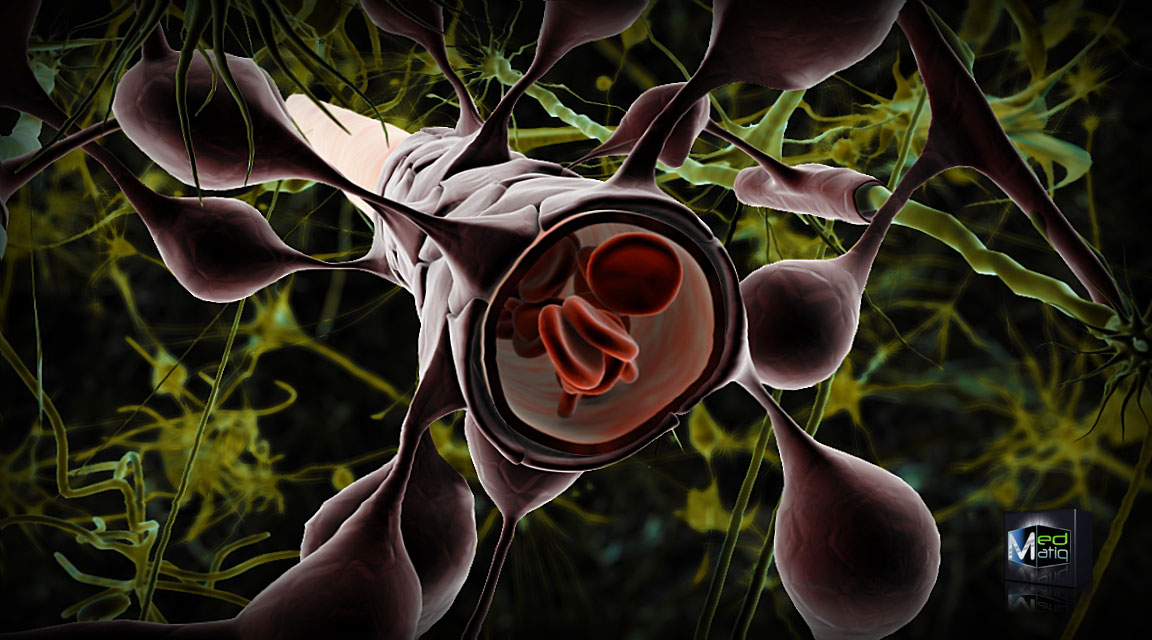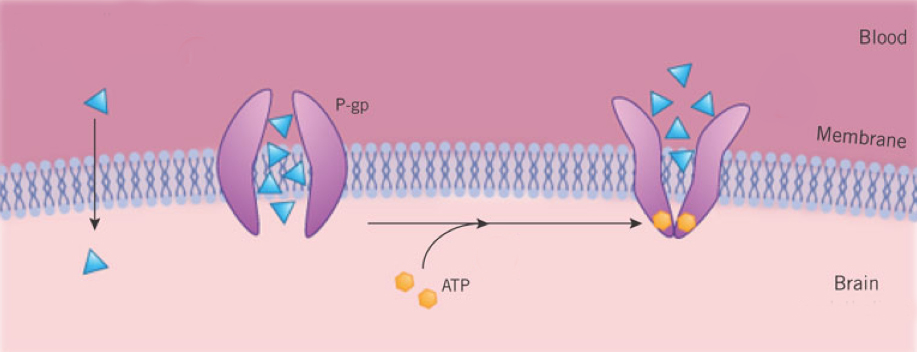
Keep out. The blood brain and spinal cord barriers fortify the walls of tiny blood vessels that snake through the brain and spinal cord - preventing toxic substances in the blood from entering the central nervous system. Image: Ben Brahim Mohammed, Wikimedia Commons.
More than 100 medicines have been tested as possible treatments for ALS. But only riluzole is FDA-approved: a drug that at best, moderately treats the disease.
A considerable obstacle toward developing more effective treatments for neurologic diseases including ALS is the blood brain and spinal cord barriers which in part, keep certain toxic substances circulating in the blood out of the central nervous system. These cellular-based barriers block potential medicines from getting into the brain and spinal cord. And, drug pumps called ABC transporters installed within these barriers kick drugs that sneak into ALS-ravaged nerves back out into the blood.
But according to a new study led by Thomas Jefferson University neuroscientist Davide Trotti PhD in Pennsylvania, creating medicines for ALS might be especially challenging because two of these drug pumps appear to kick into high gear over the course of the disease.
The researchers found that levels of ABC transporters P-glycoprotein (P-gp) and breast cancer resistance protein (BCRP) increased in people with ALS. And in mice, these pumps appeared to kick out over 50% more drugs from the spinal cord.
These ABC transporters are the same drug pumps demonstrated previously by scientists at Université Paris-Sud in France to have the ability to kick riluzole out of the brain.
The results are published this month in Neurobiology of Disease.
The US team measured the levels and pumping action of 8 ABC transporters in the blood brain and spinal cord barriers in two mouse models of ALS.

Going out? Drug pumps (purple) embedded in the blood brain and spinal cord barriers may kick potential ALS medicines (blue) out of the central nervous system (CNS) over the course of the disease - rendering them much less effective. Adapted from Osherovich, L. (2009), SciBX. Courtesy of Nature Publishing Group. All rights reserved.
The team found that the numbers of two of these drug pumps – P-glycoprotein and breast cancer resistance protein (BCRP) - appeared to increase at clinical onset - up to nearly doubling over the course of the disease.
The drug pump boost appeared to be localized to the motor cortex (muscle-moving region of the brain) and the spinal cord. The same regions ravaged by the disease.
The results demonstrate the importance of rigorous preclinical testing of emerging ALS drugs before making go/no-go decisions. This includes chronic dosing studies to determine the appropriate dosing strategy to use during testing to ensure adequate delivery to the brain and spinal cord throughout the course of the disease.
Looking ahead, the team suggests testing combination therapies that include pump blockers such GlaxoSmithKline’s elacridar and Xenova’s tariquidar to boost CNS exposure and maximize drug efficacy. First introduced as a potential therapeutic option for drug-resistant cancers, such strategies are also being tested as a possible treatment for antibiotic-resistant bacterial infections.
References
Jablonski, M.R., Jacob, D.A., Campos, C., Miller, D.S., Maragakis, N.J., Pasinelli, P. and Trotti D. (2012) Selective increase of two ABC drug efflux transporters at the blood-spinal cord barrier suggests induced pharmacoresistance in ALS. Neurobiology of Disease doi:10.1016/j.nbd.2012.03.040. Abstract | Full Text (Subscription Required)
Milane, A., Fernandez, C., Dupuis, L., Buyse,M., Loeffler, J.-Philippe, Farinotti, R.,Meininger, V. and Bensimon, G., 2010. P-glycoprotein expression and function are increased in an animal model of amyotrophic lateral sclerosis. Neuroscience Letters 472(3), 166–170. Abstract | Full Text (Subscription Required)
Milane, A., Vautier, S., Chacun, H., Meininger, V., Bensimon, G., Farinotti, R. and Fernandez, C. (2009) Interactions between riluzole and ABCG2/BCRP transporter. Neuroscience Letters 452(1), 12–16. Abstract | Full Text (Subscription Required)
Boston-Howes, W., Williams, E.O., Bogush, A., Scolere, M., Pasinelli, P. and Trotti, D. (2008) Nordihydroguaiaretic acid increases glutamate uptake in vitro and in vivo: therapeutic implications for amyotrophic lateral sclerosis. Experimental Neurology 213(1), 229–237. Abstract | Full Text
Milane, A., Fernandez, C., Vautier, S., Bensimon, G., Meininger, V. and Farinotti, R. (2007) Minocycline and riluzole brain disposition: interactions with p-glycoprotein at the blood–brain barrier. Journal of Neurochemistry 103(1), 164–173. Abstract | Full Text (Subscription Required)
Further Reading
Neuwelt, E.A. et al. (2011) Engaging neuroscience to advance translational research in brain barrier biology. Nature Reviews Neuroscience 12(3), 169-182. Abstract | Full Text (Subscription Required)
Löscher, W. and Potschka, H. (2005) Drug resistance in brain diseases and the role of drug efflux transporter. Nature Reviews Neuroscience 6(8), 591-602. Abstract | Full Text (Subscription Required)